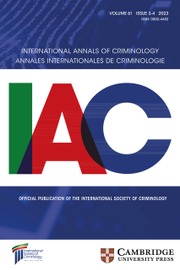No CrossRef data available.
Article contents
Transitional Justice to Address Genocide Denial: A Case Study of the Rohingya in Myanmar
Published online by Cambridge University Press: 22 November 2024
Abstract
This empirical study examines the potential and the obstacles of transitional justice in addressing the denial of the Rohingya genocide in Myanmar (also known as Burma). It utilizes a qualitative research approach, drawing on relevant scholarship of truth-seeking as a transitional justice mechanism, criminology and international law. Empirical data were collected through in-depth interviews with victims of the Rohingya community and key informants in two separate stages between 2022 and 2023. This study presents an interdisciplinary approach to assess the role of a truth commission – a truth-seeking tool – in confronting Myanmar’s denial of this crime. It suggests that examining amnesties, as well as disarmament, reintegration and rehabilitation programmes for the individual perpetrators within the framework of a truth commission can provide a more nuanced discourse of addressing the decades-long denial of the Rohingya genocide in Myanmar.
Abstracto
Este estudio empírico examina el potencial y los obstáculos de la justicia transicional para abordar la negación del genocidio rohingya en Myanmar (también conocido como Birmania). Utiliza un enfoque de investigación cualitativa, basándose en estudios relevantes sobre la búsqueda de la verdad como mecanismo de justicia transicional, la criminología y el derecho internacional. Se recopilaron datos empíricos a través de entrevistas en profundidad con víctimas de la comunidad rohingya e informantes clave en dos etapas separadas entre 2022 y 2023. Este estudio presenta un enfoque interdisciplinario para evaluar el papel de la comisión de la verdad, una herramienta de búsqueda de la verdad, para enfrentar la crisis de Myanmar y la negación de este crimen. Sugiere que examinar las amnistías, así como los programas de desarme, reintegración y rehabilitación para los perpetradores individuales en el marco de una comisión de la verdad, puede proporcionar discursos más matizados para abordar la negación durante décadas del genocidio rohingya en Myanmar.
Abstrait
Cette étude empirique examine le potentiel et les obstacles de la justice transitionnelle dans la lutte contre le déni du génocide des Rohingyas au Myanmar (également connu sous le nom de Birmanie). Il utilise une approche de recherche qualitative, s’appuyant sur des connaissances pertinentes en matière de recherche de la vérité en tant que mécanisme de justice transitionnelle, de criminologie et de droit international. Des données empiriques ont été collectées au cours d’entretiens approfondis avec des victimes de la communauté Rohingya et des informateurs clés au cours de deux étapes distinctes entre 2022 et 2023. Cette étude présente une approche interdisciplinaire pour évaluer le rôle de la Commission Vérité – un outil de recherche de la vérité – face aux problèmes du Myanmar. la négation de ce crime. Il suggère que l’examen des amnisties, ainsi que des programmes de désarmement, de réintégration et de réhabilitation pour les auteurs individuels dans le cadre d’une commission vérité, peut fournir un discours plus nuancé sur le déni du génocide des Rohingyas au Myanmar qui dure depuis des décennies.
抽象的
这项实证研究探讨了过渡时期司法在打击否认缅甸罗辛亚种族灭绝的行为方面的潜力和障碍。它采用定性研究方法,利用寻求真相的相关知识作为过渡司法、犯罪学和国际法的机制。经验数据是通过在 2022 年至 2023 年的两个不同阶段对罗辛亚社区受害者和关键知情人进行深入访谈而收集的。这项研究提出了一种跨学科方法来评估真相委员会(一个寻求真相的工具)在缅甸面临的问题上的作用。问题。否认这一罪行。它表明,作为真相委员会的一部分,审查大赦以及针对个别肇事者的解除武装、重返社会和康复计划,可以为否认缅甸已持续数十年的罗辛亚种族灭绝提供更细致的叙述。
خلاصة
للروهينجا في ميانمار (المعروفة أيضًا باسم بورما). ويستخدم نهج البحث النوعي، بالاعتماد على المعرفة ذات الصلة في البحث عن الحقيقة كآلية للعدالة الانتقالية وعلم الجريمة والقانون الدولي. تم جمع البيانات التجريبية من خلال مقابلات متعمقة مع الضحايا من مجتمع الروهينجا والمخبرين الرئيسيين خلال مرحلتين منفصلتين بين عامي 2022 و2023. وتقدم هذه الدراسة نهجًا متعدد التخصصات لتقييم دور لجنة الحقيقة - أداة للبحث عن الحقيقة - في مواجهة ميانمار. مشاكل. إنكار هذه الجريمة. ويشير التقرير إلى أن دراسة حالات العفو، وكذلك برامج نزع السلاح وإعادة الإدماج وإعادة التأهيل للجناة الأفراد كجزء من لجنة الحقيقة، يمكن أن توفر رواية أكثر دقة حول إنكار الإبادة الجماعية للروهينجا في ميانمار والتي استمرت لعقود من الزمن.
Keywords
- Type
- Article
- Information
- Copyright
- © International Society of Criminology, 2024
Footnotes
Declaration: This article includes some primary data from the Rohingya participants that the author has utilized in his research project’s working paper, supported by the East West University Centre for Research and Training (EWUCRT). The data have been analysed in a unique way in this article, leading to different conclusions to some extent.


